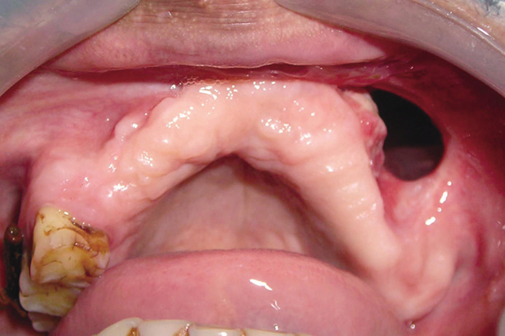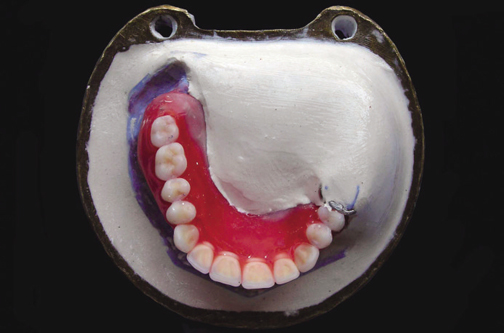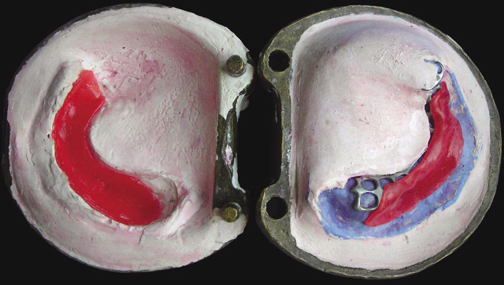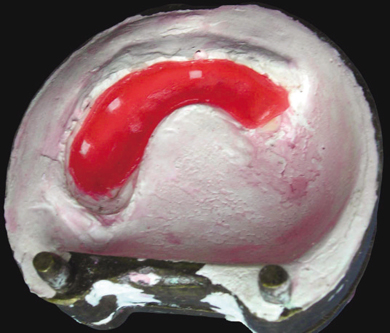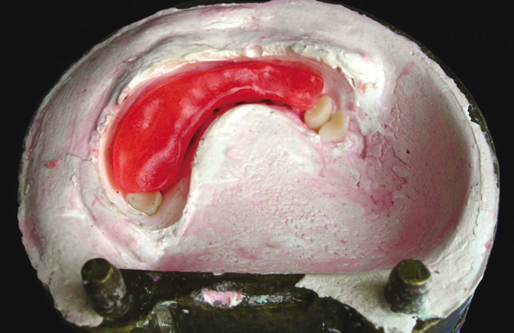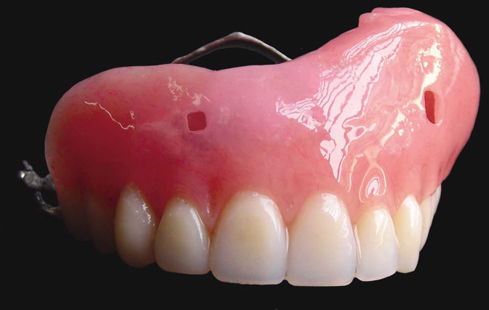J Adv Prosthodont.
2012 Nov;4(4):248-253. 10.4047/jap.2012.4.4.248.
A hollow definitive obturator fabrication technique for management of partial maxillectomy
- Affiliations
-
- 1Department of Prosthodontics, Government Dental College and Hospital, Nagpur, Maharashtra, India. pravinandsmita@yahoo.co.in
- 2Department of Orthodontics and Dentofacial Orthopedics, Swargiya Dadasaheb Kalmegh Smruti Dental College and Hospital, Nagpur, Maharashtra, India.
- KMID: 2176426
- DOI: http://doi.org/10.4047/jap.2012.4.4.248
Abstract
- Maxillary obturator prosthesis is the most frequent treatment option for management of partial or total maxillectomy. Heavy weight of the obturators is often a dislocating factor. Hollowing the prosthesis to reduce its weight is the well established fact. The alternate technique to hollow-out the prosthesis has been described in this article which is a variation of previously described processing techniques. A pre-shaped wax-bolus was incorporated inside the flasks during packing of the heat-polymerized acrylic resin to automatically create the hollow space. The processing technique described is a single step flasking procedure to construct a closed-hollow-obturator prosthesis as a single unit. To best understand the technique, this article describes management of a patient who had undergone partial maxillectomy secondary to squamous cell carcinoma rehabilitated with a hollow-obturator prosthesis.
Keyword
Figure
Reference
-
1. Spiro RH, Strong EW, Shah JP. Maxillectomy and its classification. Head Neck. 1997. 19:309–314.2. Cummings CW. Cummings otolaryngology: head and neck surgery. 2004. 4th ed. St. Louis: Elsevier;1604–1608.3. Rieger J, Wolfaardt J, Seikaly H, Jha N. Speech outcomes in patients rehabilitated with maxillary obturator prostheses after maxillectomy: a prospective study. Int J Prosthodont. 2002. 15:139–144.4. Mukohyama H, Haraguchi M, Sumita YI, Iida H, Hata Y, Kishimoto S, Taniguchi H. Rehabilitation of a bilateral maxillectomy patient with a free fibula osteocutaneous flap. J Oral Rehabil. 2005. 32:541–544.5. Pigno MA. Conventional prosthetic rehabilitation after free flap reconstruction of a maxillectomy defect: a clinical report. J Prosthet Dent. 2001. 86:578–581.6. Genden EM, Okay D, Stepp MT, Rezaee RP, Mojica JS, Buchbinder D, Urken ML. Comparison of functional and quality-of-life outcomes in patients with and without palatomaxillary reconstruction: a preliminary report. Arch Otolaryngol Head Neck Surg. 2003. 129:775–780.7. Kornblith AB, Zlotolow IM, Gooen J, Huryn JM, Lerner T, Strong EW, Shah JP, Spiro RH, Holland JC. Quality of life of maxillectomy patients using an obturator prosthesis. Head Neck. 1996. 18:323–334.8. Wu YL, Schaaf NG. Comparison of weight reduction in different designs of solid and hollow obturator prostheses. J Prosthet Dent. 1989. 62:214–217.9. Brown KE. Clinical considerations improving obturator treatment. J Prosthet Dent. 1970. 24:461–466.10. Desjardins RP. Obturator prosthesis design for acquired maxillary defects. J Prosthet Dent. 1978. 39:424–435.11. McAndrew KS, Rothenberger S, Minsley GE. 1997 Judson C. Hickey Scientific Writing Awards. An innovative investment method for the fabrication of a closed hollow obturator prosthesis. J Prosthet Dent. 1998. 80:129–132.12. Phankosol P, Martin JW. Hollow obturator with removable lid. J Prosthet Dent. 1985. 54:98–100.13. Taicher S, Rosen AG, Arbree NS, Bergen SF, Levy M, Lepley JB. A technique for fabrication of polydimethylsiloxane-acrylic resin obturators. J Prosthet Dent. 1983. 50:65–68.14. Benington IC. Light-cured hollow obturators. J Prosthet Dent. 1989. 62:322–325.15. Polyzois GL. Light-cured combination obturator prosthesis. J Prosthet Dent. 1992. 68:345–347.16. Matalon V, LaFuente H. A simplified method for making a hollow obturator. J Prosthet Dent. 1976. 36:580–582.17. Schneider A. Method of fabricating a hollow obturator. J Prosthet Dent. 1978. 40:351.18. Birnbach S, Barnhard B. Direct conversion of a solid obturator to a hollow obturator prosthesis. J Prosthet Dent. 1989. 62:58–60.19. Parel SM, LaFuente H. Single-visit hollow obturators for edentulous patients. J Prosthet Dent. 1978. 40:426–429.20. Brown KE. Fabrication of a hollow-bulb obturator. J Prosthet Dent. 1969. 21:97–103.21. Browning JD, Kinderknecht J. Fabrication of a hollow obturator with fluid resin. J Prosthet Dent. 1984. 52:891–895.22. el Mahdy AS. Processing a hollow obturator. J Prosthet Dent. 1969. 22:682–686.23. Asher ES, Psillakis JJ, Piro JD, Wright RF. Technique for quick conversion of an obturator into a hollow bulb. J Prosthet Dent. 2001. 85:419–420.24. Chalian VA, Barnett MO. A new technique for constructing a one-piece hollow obturator after partial maxillectomy. J Prosthet Dent. 1972. 28:448–453.25. Tanaka Y, Gold HO, Pruzansky S. A simplified technique for fabricating a lightweight obturator. J Prosthet Dent. 1977. 38:638–642.26. Worley JL, Kniejski ME. A method for controlling the thickness of hollow obturator prostheses. J Prosthet Dent. 1983. 50:227–229.27. Minsley GE, Nelson DR, Rothenberger SL. An alternative method for fabrication of a closed hollow obturator. J Prosthet Dent. 1986. 55:485–490.28. Beumer J, Curtis TA, Marunick MT. Maxillofacial rehabilitation prosthodontic and surgical consideration. 1996. St. Louis: Ishiyaku Euroamerica;225–247.29. Hayashi J, Nishiyama M, Miyake M, Kudo I, Nakazawa K. Construction of a maxillary prosthesis with a hollow obturator by the balloon technique and a case report. J Nihon Univ Sch Dent. 1989. 31:585–596.30. Beder OE, Todo J. Rapid technique for constructing a hollow-bulb provisional obturator. J Prosthet Dent. 1978. 39:237–239.31. Nidiffer TJ, Shipmon TH. The hollow bulb obturator for acquired palatal openings. J Prosthet Dent. 1957. 7:126–134.32. Buckner H. Construction of a denture with hollow obturator, lid, and soft acrylic lining. J Prosthet Dent. 1974. 31:95–99.33. Palmer B, Coffey KW. Fabrication of the hollow bulb obturator. J Prosthet Dent. 1985. 53:595–596.34. Gardner LK, Parr GR, Rahn AO. Combination nasal support breathing flange with hollow obturator prosthesis. A clinical report. J Prosthet Dent. 1990. 63:497–501.35. Blair FM, Hunter NR. The hollow box maxillary obturator. Br Dent J. 1998. 184:484–487.36. Habib BH, Driscoll CF. Fabrication of a closed hollow obturator. J Prosthet Dent. 2004. 91:383–385.37. Kocacikli M, Yalug S, Yazicioglu H, Yilmaz C. Fabricating a hollow obturator with visible light-cured resin system. J Prosthodont. 2008. 17:596–598.38. Shimizu H, Yoshida K, Mori N, Takahashi Y. An alternative procedure for fabricating a hollow interim obturator for a partial maxillectomy patient. J Prosthodont. 2009. 18:276–278.39. Elangovan S, Loibi E. Two-piece hollow bulb obturator. Indian J Dent Res. 2011. 22:486–488.40. Patil PG, Patil SP. Fabrication of a hollow obturator as a single unit for management of bilateral subtotal maxillectomy. J Prosthodont. 2012. 21:194–199.41. McGarry TJ, Nimmo A, Skiba JF, Ahlstrom RH, Smith CR, Koumjian JH, Arbree NS. Classification system for partial edentulism. J Prosthodont. 2002. 11:181–193.42. Morrow RM, Rudd KD, Rhoads JE. Dental laboratory procedures complete dentures. 1986. 2nd ed. St. Louis: Mosby;312–338.
- Full Text Links
- Actions
-
Cited
- CITED
-
- Close
- Share
- Similar articles
-
- Maxillofacial rehabilitation of hemi-maxillectomy patient using a closed hollow bulb obturator fabricated by one-step polymerization technique: a clinical report
- Fabrication of closed hollow obturator for hard palate defect patient undergone maxillectomy
- Prosthetic rehabilitation for a maxillectomy patient using 3D printing assisted closed hollow bulb obturator: a case report
- Implant assisted obturator in patient after maxillectomy: a case report
- Prosthetic rehabilitation of partially edentulous patient after maxillectomy: A case report

